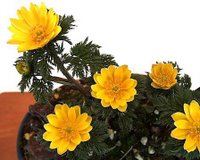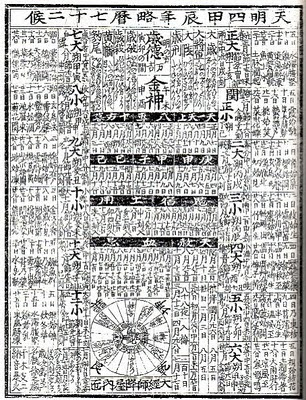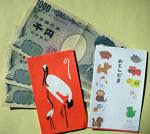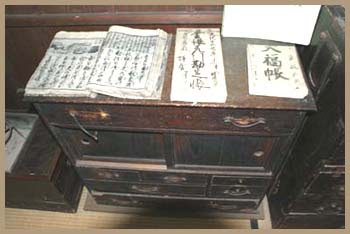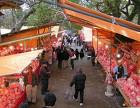[ . BACK to WORLDKIGO TOP . ]
:::::::::::::::::::::::::::::::::::::::::::::::::::::::::::::::::::::::::::::::::::::::::::::::::::
backup January 2012
. NEW YEAR Ceremonies .
[ . BACK to WORLDKIGO TOP . ]
:::::::::::::::::::::::::::::::::::::::::::::::::::::::::::::::::::::::::::::::::::::::::::::::::::
The Asian Lunar Calendar and Ceremonies
A lunar month started with no-moon, had the full moon on the 15th and 28 days to go.
The first lunar month of a year started the round of 12 months.
With the calendar reform in Japan, things changed, making the life of a haiku poet more difficult.
A new saijiki category of "New Year" has been introduced to cover the problems arising from this change of calendars.
Before changing to the Gregorian calendar, there were only the four seasons in the saijiki.
Please read the details here:
. The Asian Lunar Calendar and the
changing Dates of Japanese Ceremonies
:::::::::::::::::::::::::::::::::::::::::::::::::::::::::::::::::::::::::::::::::::::::::::::::::::
新年 SHIN-NEN Shinnen NEW YEAR The New Year is the most important time of life in Japan. Many customs and ceremonies are related to it. The season lasts from the first day of the New Year to about January 15th, the night of the full moon, the "Small New Year (koshoogatsu 小正月)" according to the Asian Lunar Calendar. Some saijiki list these ceremonies in the spring season. SAIJIKI – SPRING - SUMMER - AUTUMN ::::::::::::::::::::::::::::::::::::::::::::::::::::::::::::::::::::::::::::::::::::::::::::::::::::: 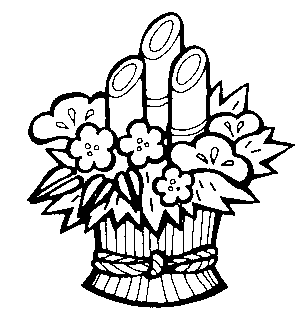 First sunrise, first sun (hatsu hi no de) : 初日の出 Read about Amaterasu Oomikami and Dainichi Nyorai, The Sun Deities of Japan : 天照大神と大日如来 First Spring (hatsu haru 初春) and related kigo ::::::::::::::::::::::::::::::::::::::::::::::::::::::::::::::::::::::::::::::::::::: WKD : "First" ceremonies of the year : The following are explained in the above LINK: ..... Daruma Market 達磨市 Daruma Ichi fuku Daruma 福達磨(ふくだるま)Daruma for good luck Daruma mise 達磨店(だるまみせ)shop to sell Daruma dolls Hatsu Yakushi 初薬師 First Ceremony for Yakushi Nyorai Healing Buddha, Buddha of Medicine Hatsu Kannon 初観音 First Kannon Ceremony 初大師 Hatsu Daishi : First Kooboo Daishi Festival Kobo Daishi, Kukai 初地蔵 Hatsu Jizoo : First Jizoo Bosatsu Ceremony 初不動 Hatsu Fudo O-Fudo-Sama in Japan 初護摩 Hatsu-goma, First Fire Ceremony Oyama Fudo, Fire Ceremony hatsu shakyoo 初写経 : First Copying of the Sutras 初勤行: Hatsu-gongyoo, First Reading of the Sutras ..... 初鐘,初読経,初燈明,初燈 hatsu suzuri 初硯(はつすずり) first (use of the) inkstone 弓始 : Yumi Hajime, First Drawing of the Bow ..... hatsuya 初矢 Shooting of the year's first arrow : Japanese Archery (kyuudoo) 弓道 ..... iba hajime 射場始(いばはじめ)、mato hajime 的始(まとはじめ)、yumiya hajime 弓矢始(ゆみやはじめ)、izome 射初(いぞめ)、hatsu yumi 初弓(はつゆみ) ..... see also Noriyumi below. hatsuya 初矢 Shooting of the year's first arrow at Sanjusan Gendo ..... Sanjuusan Gendoo no yooji joosui kaji 三十三間堂の楊枝浄水加持 (さんじゅうさんげんどうのようじじょうすいかじ) warding off headache with a willow branch at Sanjusan Gendo First visit to a temple or shrine (hatsumode, hatsu moode 初詣) The Basics ! ::::::::::::::::::::::::::::::::::::::::::::::::::::::::::::::::::::::::::::::::::::: Some more FIRST ceremonies : Hatsu Asama, hatsu sengen 初浅間 First view of or visit to the Asama Shrine (Mt. Fuji) Hatsu Asama 初浅間 First view of or visit to Mount Asama, near Karuizawa Town Hatsu Atago 初愛宕 (はつあたご) First visit to Atago and Bishamonten at Atago Hatsu Basho, 初場所 First Sumo Tournament ..... January Tournament, ichigatsu basho 一月場所, New Year Tournament, shoogatsu basho 正月場所 Hatsu Benten, 初弁天 First visit to a Benten Shrine Hatsu Daikoku 初大黒(はつだいこく)first Daikoku ceremony Daikoku matsuri 大黒祭(だいこくまつり)Daikoku festival hatsu ki no e ne 初甲子 (はつきのえね) first day of the rat and the element water ..... hatsu kasshi 初甲子(はつかっし) Hatsu Enma 初閻魔 (はつえんま) First Ema "God of Hell" First Visit to a Temple to the God of Hell ..... Enma mairi 閻魔詣(えんままいり) ..... Day off, sainichi 斎日(さいにち) ..... First visit to the 10 kings of hell, ..... juuoo mairi 十王詣(じゅうおうまいり) Hatsugatsuo no shinku 初鰹神供 (はつがつおのしんく) offering first bonito (katsuo) Tsurugaoka Hachimangu, Kamakura Hatsu Hiei, 初比叡 First Visit to Temple Hiei-zan Mount Hiei (比叡山, Hiei-zan), Kyoto, Temple Enryaku-ji 延暦寺 Hime hajime ひめ始 ひめはじめ 姫始(ひめはじめ) Beginning of first female activities January 2. Court rituals. ..... hime hajime 飛馬始(ひめはじめ)、hime hajime 姫糊始(ひめはじめ)、hime hajime 火水始(ひめはじめ)、hime hajime 密事始(ひめはじめ) Hatsu i, hastu-i 初亥 (はつい) first day of the Wild Boar Hatsu Ise 初伊勢 First visit to the Ise Shrine Hatsu Kagura 初神楽, 神楽始 First Kagura Dance Hatsu Kokuuzoo 初虚空蔵 (はつこくうぞう) First Kokuzo Ceremony Hatsu Konpira 初金毘羅 First Visit to Kompira Shikoku, Konpira Shrine Hatsu kukai 初句会 First Haiku Meeting a KIGO list Mari hajime 鞠始 まりはじめ First Kickball Game court ritual. ..... kemari hajime 蹴鞠始(けまりはじめ)、hatsu mari 初鞠(はつまり) Hatsu Myooken 初妙見 (はつみょうけん) First Myoken Bosatsu Ceremony Noo hajime, 能初 (のうはじめ) first Noh performance hatsunoo 初能(はつのう) First Noh Theater performance butai hajime 舞台始(ぶたいはじめ)first stage onoo hajima 御能始(おのうはじめ)first honorable noh performance . . . hatsu oogi 初扇 (はつおうぎ) first use of the folding fan Hatsu Shibai 初芝居 First Kabuki Theater Performance ..... ni no kae, ni no kawari 二の替 ..... First Kyogen, hatsu kyoogen 初春狂言, spring performance, haru shibai 春芝居 ..... First Soga Performance, hatsu soga 初曽我 (The Revenge Story of the Soga Brothers) Koosho hajime 講書始 First official lecture at the Imperial Court ..... hatsu koosho 初講書(はつこうしょ) Hatsu misa 初弥撒 (はつミサ) first missa, first mass ..... misa hajime 弥撒始(ミサはじめ) Erste Messe kami no haha seibo maria no iwai 神の母聖マリアの祝日 (かみのははせいマリアのいわいび) celebrating Maria, mother of God Hatsu Shooten 初聖天 (はつしょうてん) First Shoten Ceremony Shoten, Kankiten, Ganesh the Elephant-headed deity Hatsu Suitenguu 初水天宮 (はつすいてんぐう) first visit to the Suitengu Shrine hatsu mi 初巳 (はつみ) "first snake". first day of the snake hatsu Benzaiten 初弁財天(はつべんざいてん)first visit to a Benten shrine ..... hatsu Benten 初弁天(はつべんてん) fuse mairi 布施参(ふせまいり)visit a Benten shrine(mairi) and make an offering (fuse) ..... Minoo no tomi 箕面の富 (みのおのとみ) lottery at Minoo ..... Minoo san Benzaiten mairi 箕面山弁財天参(みのおさんべんざいてんまいり)/ 辨財天 Visiting Benten at Mount Minoo Hatsu Taishaku 初帝釈(はつたいしゃく)first Taishaku ceremony Taishaku Ten mairi 帝釈天詣(たいしゃくてんまいり)visiting a temple of Taishaku ..... Taishaku mairi 帝釈詣(たいしゃくまいり) hatsu Kooshin 初庚申( はつこうしん) first Koshin ceremony Kooshin machi 庚申待(こうしんまち) "waiting for Koshin" waiting for the sun Day of the Monkey and the element metal : ka no e saru Hatsu tatsu 初辰 (はつたつ) "first dragon" ..... jooshinnichi 上辰日(じょうしんにち) Tatsu matsuri 辰祭(たつまつり)Dragon Festival hatsu tatsu no mizu 初辰の水(はつたつのみず) first water for the dragon . . . shio no mizu 潮の水(しおのみず)"tide water" (to throw on the roof) Hatsu Tenjin 初天神 First visit to a Tenjin Shrine Hatsu Tora 初寅 (はつとら) First Day of the Tiger visit to Kurama Temple in Kyoto on the first day of the tiger, Kurama hatsu tora mairi 鞍馬初寅詣(くらまはつとらまいり) hatsu tora mairi 初寅詣(はつとらまいり) "First Tiger", ichi no tora 一の寅(いちのとら); ..... kami no tora no hi 上寅日(かみのとらのひ); "lucky tiger" fuku tora 福寅(ふくとら) "rake for good luck" fuku kaki 福掻, 福かき(ふくかき);"lowering the basket" fugo oroshi 畚下し, 畚降ろし(ふごおろし) "lucky centipede", o-fuku mukade お福むかで(おふくむかで);"Kurama Gold Coin", Kurama koban 鞍馬小判(くらまこばん) ..... Kurama mairi 鞍馬詣(くらままいり) pilgrimage to Mount Kurama Hatsu Tsukuba 初筑波 はつつくば . First view of Mt. Tsukuba Hatsu U (hatsu-u) 初卯 (はつう) first day of the rabbit/hare hatsu-u matsuri 初卯祭(はつうまつり)first day of the rabbit festival hatsu u mairi 、初卯詣(はつうまいり)visiting a shrine for the rabbit festival u no fuda 卯の札(うのふだ)"rabbit votive tablet" (for this day) ni no u 二の卯(にのう)second day of the rabbit san no u 三の卯(さんのう)third day of the rabbit Kameido Myoogi mairi 亀戸妙義参(かめいどみょうぎまいり) in memory of Sugawara Michizane 菅原道真 Uma norizome 馬騎初 うまのりぞめ First riding of the horses ..... kiba hajime 騎馬始(きばはじめ)、nori hajime 騎始(のりはじめ)、norizome 騎初(のりぞめ)、hatsu nori 初騎(はつのり) baba hajime 馬場始(ばばはじめ)"first riding ground" Imperial Court Ceremony. Utaizome 謡初,初謡 hatsu uta, First reading of poetry, court ritual ..... utakai hajime 歌会始 うたかいはじめ ..... uta gokai hajime 歌御会始(うたごかいはじめ)、waka gokai hajime 和歌御会始(わかごかいはじめ)、gokai hajime 御会始(ごかいはじめ) Hatsu Warai, first laughter, smile With Ebisu, the God of Good Luck If your FIRST word is not in the above list, it may not be in the category for "observances". For a list of more New Year FIRST items, CLICK HERE ! WKD : Other "First Things" (hatsumono) of Japan in other seasons ::::::::::::::::::::::::::::::::::::::::::::::::::::::::::::::::::::::::::::::::::::::::::::::::::::: ::::::::::::::::::::::::::::::::::::::::::::::::::::::::::::::::::::::::::::::::::::::::::::::::::::: Agatameshi no jimoku 県召除目 (あがためしのじもく) Giving first orders to local governors (at the Heian court) ..... 県召の除目 ..... agatameshi 県召(あがためし)、haru no jimoku 春除目(はるのじもく) . . . . . ..... Aouma 白馬の節会 White Horse Court Ritual Aouma, Ao uma no sechi e, hakuba no sechi-e 白馬節会 (あおうまのせちえ) White Horse Festival Court ritual on January 7 ..... ume ga e utau 梅が枝うたう(うめがえうたう) Poetry for plum blossoms ..... aoyagi utau 青柳うたう(あおやぎうたう)Poetry for willow branches ..... ooroku 女王禄 おうろく , 女王禄を賜う(おうろくをたもう) ..... nyojo i 女叙位 にょじょい , 女叙位(おんなじょい) On the day after the White Horse. Women and Haiku . . . . . and Ao-uma no matsuri 青馬祭 (あおうまのまつり) Festival of the White Horse ..... aouma no matsuri 白馬祭(あおうまのまつり) ..... hakubasai 白馬祭(はくばさい)White Horse Festival . . . . . Atsuta tooka shinji 熱田踏歌神事 (あつたとうかしんじ) Atsuta shrine dance and song ceremony Nagoya Azukigayu 小豆粥 (あずきがゆ) Rice gruel with small soybeans * ..... rice gruel on the 15th, juugonichi gayu 十五日粥(じゅうごにちがゆ) rice gruel with red soybeans, azukigayu 赤小豆粥(あずきがゆ) rice gruel eaten on the full moon day "mochi", January 15, mochi no kayu 望の粥(もちのかゆ. 餅粥 usually it includes some rice cakes (mochi) and a few more kigo with rice gruel: mochi put in rice gruel, kayu bashira 粥柱 (かゆばしら) "rice gruel stick" kayuzue 粥杖 (かゆづえ) kayu no ki 粥の木(かゆのき) ..... kayugi 粥木(かゆき) fukuzue 福杖(ふくづえ) ..... iwai boo、祝棒(いわいぼう) divination with rice gruel, kayu ura 粥占 (かゆうら) ceremony for ... kayu ura shinji 粥占神事(かゆうらしんじ) kayu dameshi 粥試し(かゆだめし) kayu ura matsuri 粥占祭(かゆうらまつり) ..... kudakayu matsuri 管粥祭(くだかゆまつり) "gruel in pipes" kudakayu 管粥(くだかゆ) ..... tsutsugayu 、筒粥(つつがゆ) pipe .. tsutsu 筒(つつ) o-kayu matsuri 御粥祭(おかゆまつり)..kayu shinji 粥神事(かゆしんじ) nanakusa gayu 七草粥(ななくさがゆ) nanoka gayu 七日粥(なのかがゆ) Binzuru Mawashi 賓頭盧廻 Ceremony for Saint Binzuru ..... びんづるまはし, ひんつるまはし, びんずるまわし Bishamon no tsukai 毘沙門の使 Bishamonten Festival, Messenger of Bishamonten Indian Deity Vaishravana Bonten 梵天, ぼんでん Indian Deity Brahman Bonten matsuri 梵天祭 (ぼんてんまつり) Bonten festival, Akita 梵天奉納祭(ぼんてんほうのうさい)Bonten hoonoosai Chakkirako ちゃっきらこ / チャッキラコ Chakirako dance festival hatsu Ise odori 初伊勢踊 first Ise dance hiyari odori 日やり踊 sagichoo odori 左義長踊 Sagicho Dance Cha no yu, 茶の湯, Tea Ceremony ..... 初釜 Hatsugama, First Tea Ceremony 初茶湯 Hatsu Cha no yu, 初点前 Hatsu temae Chooga 朝賀 Court ritual of First Morning Audience haiga 拝賀(はいが)、sanga 参賀(さんが) more : First Court Rituals. Daijin ke no daikyoo 大臣家大饗 だいじんけのだいきょう First audience of the Ministers. Since the Heian period. ..... omoya no daikyoo 母屋の大饗 もやのだいきょう Dainichi mairi 大日詣 First vitit to the Dainichi Hall in Akita, Kazuno dainichidoozaidoo 大日堂祭堂(だいにちどうざいどう), zaidoo 祭堂(ざいどう) Dezome 出初 でぞめ First Parade of the Tokyo fire brigade ..... shooboo dezome 消防出初(しょうぼうでぞめ) dezome shiki 出初式(でぞめしき)、hatsu de 初出(はつで)、 ..... first fire alarm bells, dezome gane 出初鐘(でぞめがね)、 ..... first climbing of the ladders, hashigo nori 梯子乗(はしごのり) Doosojin matsuri 道祖神祭 (どうそじんまつり) Dosojin Festival of the Wayside Deities Sai no kami matsuri 塞の神祭(さいのかみまつり) ..... 幸の神祭(さいのかみまつり)Sai no Kami festival Doorokujin matsuri 道禄神祭(どうろくじんまつり) Doya Doya どやどや Doyadoya Festival at Shitenno-Ji Osaka . . . . and Tennooji shoojin ku 天王寺生身供 (てんのうじしょうじんく) Birthday Ritual shari dashi 舎利出し(しゃりだし)"showing of the sacred bones" ................................................................................. Ebisu, Ceremony for the God of Wealth and Prosperity 若夷, 夷おろし ..... Kairaishi 傀儡師, 傀儡, 夷廻し,木傀廻し ..... Visiting the Seven Gods of Good Luck, shichi fukujin mairi 七福神詣 ..... 七福詣, 福神詣, 福神巡り, 福詣 Palanquin of fortunes, hoikago宝恵駕, hoekago 宝恵駕籠* Ebisu palanquin, Ebisu kago 戎籠(えびすかご) Palanquin for Fukusuke, Fukusuke kago 福助駕(ふくすけかご) Itsuka Ebisu 五日戎 (いつかえびす) Ebisu on January 5 Hatsuka Ebisu 二十日戎 (はつかえびす) Ebisu on January 20 hatsuka Ebisu matsuri 二十日戎祭(はつかえびすまつり) Ebisu Ceremonies in Edo and the Kanto area Tooka Ebisu 十日戎 (とおかえびす) Ebisu on January 10 (in the Kansai area) hatsu Ebisu 初戎(はつえびす)first Ebisu rituals yoi Ebisu 宵戎(よいえびす), Ebisu matsuri 戎祭(えびすまつり)Ebisu festival nokori Ebisu 残り戎(のこりえびす)"left over Ebisu" nokorifuku, nokori fuku 残り福(のこりふく) ..... fukusasa 福笹(ふくささ) Ebisu sasa 戎笹(えびすささ) fukuame, fuku ame 福飴(ふくあめ)"sweets for good luck" kichoo 吉兆(きっちょう)"good omen" ................................................................................. Ehoo Moode 恵方詣 Visit in the auspicious direction ..... Ehoo mairi, auspiciuos direction, ehoo 恵方(えほう)、ehoo michi 恵方道(えほうみち)、ehoo 吉方(えほう)、兄方(えほう)、得方(えほう)、元方(えほう)、aki no kata 明の方(あきのかた), praying in the auspicious direction, ehoo ogami 恵方拝(えほうおがみ) Enburi Dance 柄振り えんぶり、えぶり Japan, Aomori. Enjusai 延寿祭 (えんじゅさい) Enju "Long Life" Ceremony at Kaibara Shrine, Nara Pref. Enju Sake Cup, enju hai 延寿盃(えんじゅはい), Enju Chopsticks, enju bashi延寿箸(えんじゅばし) Ennen no Mai 延年の舞 Dance for a long life hatsuka yomatsuri 二十日夜祭(はつかよまつり) night festival on January 20 Matarajin Matsuri 摩多羅神祭(まだらじんまつり) festival in honor of Matarajin . . . . . most famous is 平泉毛越寺延年の舞 Hiraizumi, Motsu-Ji Ennen no Mai Eyoo 会陽 "Ee yoo Ceremony" ..... Saidaiji Mairi 西大寺参, shingi 神木 hadaka oshi 裸押し "naked men pushing and shoving" shuushoo-e 修正会 Saidaiji Hadaka Matsuri, 西大寺裸祭り Naked Man Festival at temple Saidaiji (Okayama) Fuigo hajime 鞴初 、吹革初 First use of the bellows Fuku Warai 福笑い (ふくわらい) First laugh, hatsu warai. first cry, hatsu naki ................................................................................. Ganjitsu no Sechi-E 元日節会 Court ritual of Reception and Audience of Politicians ..... shoshinosoo 諸司奏(しょしのそう)、 ..... shichiyoo no goriyaku no soo 七曜御暦奏(しちようのごりやくのそう)、 ..... hi no tameshi no soo 氷様奏(ひのためしのそう)、 ..... haraka no soo 腹赤奏(はらかのそう) ..... kuzu no soo 国栖奏(くずのそう)PHOTOS ! ..... hiraza no gezan 平座見参(ひらざのげざん)、 ..... shinnen enkai 新年宴会(しんねんえんかい) Ganzan Daishi-E 元三大師会 Ceremony for Ganzan Daishi at temple Jindaj-Ji 深大寺 Go han itadaki 御印文戴き (ごはんいただき) "getting a honorable stamp" Temple Zenko-Ji, Nagano Go-Oo Kaji 牛王加持, 牛黄加持Ceremony of the Ox King Deity (Ox King Buddha) 東寺牛王加持 (とうじごおうかじ, とうじごわうかぢ) ..... Funa Go-Oo 舟牛王ふなごおう,ふなごわう, Ship Go-Oo ..... and Kiyomizu no Go Ou 清水の牛王 (きよみずのごおう) Go-Oo ritual at tempel Kiyomizu-dera Kiyomizudera go oo 清水寺牛王(きよみずでらごおう) Kiyomizudera goo zue 清水寺牛王杖(きよみずでらごおうづえ) Go-Oo stick at Kiyomizu Temple ..... and Sensooji go oo kaji 浅草寺牛王加持 (せんそうじごおうかじ) at Asakusa Kannon, Tokyo ..... Go-Oo Kaji-E 牛王加持会 at Asakusa Temple 浅草寺 Hachi Tataki 鉢叩 鉢敲, 鉢扣 "banging the prayer gongs" Hachi Tataki Dezome 鉢叩出初 First prayer round whilst banging gongs Memorial Service for Saint Kuuya Shoonin 空也上人 Kuuya Doo Hachitataki Dezome 空也堂鉢叩出初 (くうやどうはちたたきでぞめ) at Kuya Hall hachitataki dezome 鉢叩出初(はちたたきでぞめ) zuda junki dezome 頭陀巡行出初(ずだじゅんぎょうでぞめ) (zuda also means hachi tataki) Hakone ekiden 箱根駅伝 Hakone Ekiden Race Hakone Relay Marathon Hagatame はがため . Teeth strengthening Ceremony ..... rice cakes for strengthening the teeth ..... hagatame no mochi 画固の餅 はがためのもち ..... Diamond Petal Rice Cakes, hishi hanabira mochi, 菱葩餅 ..... "auspicious hard things" o-iwai kachin お祝いかちん(おいわいかちん) ..... ..... o-iwai okachin お祝いおかちん Hakubasai, hakuba sai 白馬祭(はくばさい) Festival of the White Horse Hama ogami 浜拝 はまおがみ Offering prayers at the beaches January first ..... First Tide, wakashio 若潮 わかしお ..... wakashio mukae 若潮迎え(わかしおむかえ)、hatsu hama 初浜(はつはま)、 ..... Selling new salt, waka shio uri 若塩売(わかしおうり)、waka shio iwai 若塩祝い(わかしおいわい) Hare no Gozen 晴の御膳 Official Lunch Reception at the Imperial Court ..... Hare no Omono 晴御膳 はれのおもの ..... Gozen no gi 御膳の儀 Harugitoo 春祈祷(はるぎとう)spring prayer ..... gongen mai 権現舞 (ごんげんまい) Gongen Dance ..... gongen sama 権現様(ごんげんさま) ..... kado-uchi 門打(かどうち) ..... ha-uchi 歯打(はうち) (haru kitoo) Hatsuka iwai 二十日祝 January 20 Celebration ..... "sword handle" celebration, ha tsuka iwai 刃柄祝(はつかいわい), Celebration of the mirror box, kyoodai iwai 鏡台祝(きょうだいいわい), Celebration of the "first face", hatsu kao iwai 初顔祝(はつかおいわい)、Celebration of the Mirror, kagami no iwai 鏡の祝(かがみのいわい) Himachi, hi machi 日待 (ひまち) waiting for the (first) sun Hino no Hadaka Odori 日野の裸踊 Naked Dance in Hino Hitachi obi no shinji 常陸帯の神事 (ひたちおびのしんじ) Hitachi Belt Ceremony Hitachi obi no matsuri 常陸帯の祭(ひたちおびのまつり) Hitachi obi 常陸帯(ひたちおび)"Belt from Hitachi" Kashima no obi 鹿島の帯(かしまのおび)"Belt from Kashima" enmusubi no shinji 縁結び神事(えんむすびしんじ) ceremony for finding a partner Hotoke Shoogatsu 仏正月 (ほとけしょうがつ) New Year of the Buddhas/ancestor souls ..... hotoke no shoogatsu 仏の正月(ほとけのしょうがつ) day of the ancestors, hotoke no hi 仏の日(ほとけのひ) ..... ancestors passing into the new year, hotoke no toshikoshi 仏の年越(ほとけのとしこし) hotoke no kuchi ake 仏の口明(ほとけのくちあけ) nenbutsu no kuchi ake 念仏の口明(ねんぶつのくちあけ) New Year of the Ancestors, sensoo shoogatsu 先祖正月(せんぞしょうがつ) Beginning of the Temple Year, tera nenshi 寺年始(てらねんし) ................................................................................. Ichigami matsuri 市神祭 (いちがみまつり) festival for the God of the Market Imigomori 亥巳籠 (いみごもり) respectful retreat from the first day of the wild boar (i 亥) to the day of the snake (mi 巳) ..... Kako no monoshizume 加古の物鎮(かこのものしずめ) seclusion at Kakogawa, Hyogo Inari no bushasai 稲荷の奉射祭 (いなりのぶしゃさい) first shooting at the Inari shrine bushasai, busha sai 歩射祭(ぶしゃさい) onyumihajimesai, on yumi hajime sai 御弓始祭(おんゆみはじめさい) . . . . . and Inari Ooyama sai 稲荷大山祭 Oyama Fox God Festival shimehiki 注連曳き(しめひき)bringing new sacred ropes Inari shimehari 稲荷注連張(いなりしめはり) Inari sacred rope shimehari shinji 注連張神事(しめはりしんじ) kawarake hiroi 土器拾い(かわらけひろい)picking up ritual clay dishes okawarake, o kawarake 御土器(おかわらけ)honorable clay dishes - at Fushimi Inari Shrine, Kyoto 伏見稲荷大社 In no Hairai 院の拝礼 First Court Ceremony Itsukushima Jinja no toshikoshisai 厳島神社の年越祭 (いつくしまじんじゃのとしこしさい) Crossing into the new year at Itsukushima shrine . . . . . and Itsukushima no on yumi hajime 厳島の御弓始 (いつくしまのおんゆみはじめ) kisha 鬼射(きしゃ)"hitting the demon" onyumi shinji 御弓神事(おんゆみしんじ) honorable ceremony of the bow - at Miyajima, 宮島の大元神社 Omoto shrine ceremony. Hiroshima Joi 叙位 (じょい) official bestowing of a rank or title Joogen, jogen, 上元 First third of the year ..... shongan しょんがん、 genshoosai 元宵祭(げんしょうさい)、 genshoosetsu 元宵節(げんしょうせつ)、genshoo 元宵(げんしょう)、joogen e 上元会(じょうげんえ)、joogen no hi 上元の日(じょうげんのひ), genseki 元夕(げんせき ), ceremony of praying for good luck, kifuku sai 祈福祭(きふくさい), changing the candles, roosoku kae 蝋燭替(ろうそくかえ) ..... Lantern festival (Yuanxiao 元宵節) China Juuhachi Gayu 十八粥 Rice Gruel on the 18th day Juurokunichi sai 十六日祭 (じゅうろくにちさい) festival of the 16th day mii juukokunichi 新十六日(みいじゅうろくにち)new 16th day koodooroo 香燈籠(こうどうろう)fragrant lanterns Okinawa Juuyokka toshikoshi 十四日年越, 十四日年越し celebration of January 14 To pass safely over into a new circle with the full moon on lunar first month, day 15. ..... juuyokka dango 十四日団子(じゅうよっかだんご) dango dumplings eaten on day 14 of the lunar first month ................................................................................. Kagihiki shinji 鉤引神事 (かぎひきしんじ) ritual of pulling with hooks ..... 鉤引(かぎひき)pulling with wooden hooks Kagura Dance 神楽 Hatsu Kagura, First Kagura Dance Kaji hajime 鍛冶初, First use of the smithy ..... Hatsu kamado 初竃, first fire in the stove Kamakura かまくら "snow hut" ..... yukimuro 雪室 (ゆきむろ) Festival for children in Akita on January 15. Kamigamo Nentoosai 上賀茂燃燈祭 (かみがもねんとうさい) "Lantern Festival at Kamigamo" hatsune no tamabooki 初子の玉箒(はつねのたまぼうき) "precious broom on the first day of the rat" - at Kamigamo Shrine, Kyoto 上賀茂神社 Kasetori かせとり"Imitating the Cock's Call" ..... kasedori かせどり, カセ鳥 kakkadori かっかどり, kasegidori かせぎどり, hotohoto ほとほと Kashima no kotobure 鹿島の事触 (かしまのことぶれ) Kashima diviners, itinerant priests ..... kotobure 言触(ことぶれ) Kasuga no o-taue matsuri 春日御田植祭 (かすがのおたうえまつり) rice planting ritual at Kasuga shrine Kyoto sometimes placed as mid-spring kigo Kawazugari no shinji 蛙狩の神事 (かわずがりのしんじ) ceremony of hunting for frogs Frog Hunting Shrine Ritual ..... kawazutobi no shinji 蛙飛びの神事(かわずとびのしんじ) frog-jumping ritual. at Suwa Shrine, Nagano Kayutsuri 粥釣, 粥つり かゆつり "Fishing for rice gruel" Kenpai Shiki 献盃式 Ceremony of drinkingin memory of Shinran Shoonin Kijizake (kiji sake) 雉子酒 "Pheasant ricewine" kiji shu 雉子酒(きじしゅ) - o kiji おきじ Court ritual Kitano no fudehajime sai 北野の筆始祭 (きたののふではじめさい) first use of the brush ceremony at Kitano Kitano Tenmangu in Kyoto 北野天満宮 京都 Kitoo-gitsune 祈祷狐(きとうぎつね)prayer to the Fox deity (kitsune) ..... kitsune mai 狐舞 (きつねまい) fox dance ..... inariyama no shirogitsune 稲荷山の白狐(いなりやまのしろぎつね)the white fox from Inari mountain Kokuseki-Ji Hadaka Matsuri 黒石寺裸祭 Kokuseki Temple Naked Festival Kuroishi Hadaka Matsuri 黒石裸祭 ..... Sominsai 蘇民祭 Komatsu hiki 小松引 pulling out small pine seeldings ..... First Day of the Rat, hatsune 初子 ..... dress for the day of the rat, ne no hi goromo 子の日衣 and a few more kigo of this day ................................................................................. Manaita biraki, manaitabiraki 俎開 (まないたびらき) first use of the chopping board Matsubayashi 松囃子 まつばやし First official performance of the arts ..... 松拍子(まつばやし)、o utaizome 御謡初(おうたいぞめ) suoo nugi 素襖脱ぎ(すおうぬぎ)taking off the suoo ceremonial robe Matsumoto no shio-ichi 松本の塩市 (まつもとのしおいち) salt market in Matsumoto ..... First market in Matsumoto, Matsumoto no hatsu ichi 松本の初市 ..... Sweets Market, ame ichi 飴市(あめいち) Matsurigoto hajime 政始 beginning of political activities Mikamaki 御薪 Honorable fire wood ..... mimaki 御薪(みまき)、mikamaki tatematsuru 御薪奉る(みかまぎたてまつる) Old court ritual. Mikusuri o kuuzu 御薬を供ず offering honorable medicine ..... toso 屠蘇(とそ)ritual ricewine byakusan 白散(びゃくさん) doshoosan, toshoosan 度嶂散(どしょうさん) kusurigo 薬子(くすりご)"child drinking medicine" Mino-o no Tomi 箕面の富 Lottery at Mino Minoo san Benzaiten mairi 箕面山弁財天参( みのおさんべんざいてんまいり)/ 辨財天 Visiting Benten at Mount Minoo otomi hoo-e 御富法会(おとみほうえ) Minoo tomitsuki 箕面富突(みのおとみつき) picking a lottery ticket in Minoo ichi no tomi 一の富(いちのとみ)first lottery win ni no tomi 二の富(にのとみ)second lottery win san no tomi 三の富(さんのとみ)third lottery win tomifuda 富札(とみふだ)lottery ticket ..... o-tomi san お富さん(おとみさん) Mishima otauchi matsuri 三島御田打祭 (みしまおたうちまつり) festival of "hitting the fields at Mishima O-tauchi 御田打(おたうち)"honorable hitting the fields" Onta matsuri 御田祭(おんたまつり)festival of the fields Mogura-uchi 土龍打 もぐらうち "hitting the moles" ..... mogura oi 土龍追(もぐらおい) sending the moles away, mogura okuri 土龍送り(もぐらおくり) urokomochi uchi うろこもち打(うろこもちうち 望打ち) Mooja Okuri 亡者送り Seeing Off the Dead, driving out the devil Sensooji moosha okuri 浅草寺亡者送り (せんそうじもうじゃおくり) Asakusa, Moja Okuri Myooga matsuri ... 茗荷祭 (みょうがまつり)Myoga Festival also Bamboo shoots Ritual, take no ko shinji 筍神事(たけのこしんじ) ................................................................................. Nagataki Hakusan Jinja muikasai 長滝白山神社六日祭 (ながたきはくさんじんじゃむいかさい) Festival on the 6th day at Nagataki Hakusan Shrine Gifu hana ubai matsrui 花奪い祭 "festival of taking blossoms by force" Namahage なまはげ Demons driving out bad spirits ..... Namomihagi なもみ剥ぎ, amamihagi あまみはぎ namamihagi 生身剥(なまみはぎ)、nagomehagi なごめ剥(なごめはぎ)、namomitakuri なもみたくり、ひがたたくり、nanamitakuri ななみたくり、namomihagi なもみ剥(なもみはぎ) Nanakusa 七種、七草 the seven herbs of Spring with many related kigo Naoi no shinji 儺追の神事 (なおいのしんじ) Naoi ritual for driving away evil ..... naoe matsuri 直会祭(なおえまつり) Naoe festival ..... naoi matsuri 儺追祭(なおいまつり) Naoi Festival Shrine Konomiya, Inazawa, Aichi Natsumigawa no shinji 菜摘川の神事 (なつみがわのしんじ) ritual of picking herbs at Na-tsumi river Yoshino Nara no Yamayaki 奈良の山焼 burning the mountain slopes at Nara ..... Burning the mountains, o-yama yaki お山焼(おやまやき) Narikizeme 成木責 tree fertility ritual ..... nari iwai 成祝(なりいわい) cheering the tree, ki o hayasu 木を囃す(きをはやす) naruka naranuka なるかならぬか Niino no yukimatsuri 新野の雪祭 (にいののゆきまつり) snow festival at Niino dengaku matsuri 田楽祭/雪祭り Dengaku dance festival yuki matsuri 田楽祭/雪祭り Snowfestival Nishinomiya no igomori 西宮の居籠 (にしのみやのいごもり) recluse at Nishinomiya ..... igomori 居籠(いごもり) Ebisu festival at Nishinomiya Hyogo. Nishi Shichijoo taue shinji 西七条田植神事 (にししちじょうたうえしんじ) rice planting ceremony at Nishi Shichijo village Kyoto Nishiura dengaku 西浦田楽 (にしうれでんがく) Dengaku dance at Nishiura village Nonomiya matsuri (No no Miya)箟宮祭 (ののみやまつり) Nonomiya festival Nonotake Hakusan matsuri 箟岳白山祭(ののたけはくさんまつり) Mount Nonotake Hakusan Festival Nnoriyumi 賭弓 bow shooting contest ..... noriyumi 賭射(のりゆみ) keari aruji 還饗(かえりあるじ) noriyumi no sechi 賭弓の節(せち) Nyoodoosai 繞道祭 (にょうどうさい) Nyoodoo FestivalNyodo Fire Festival ................................................................................. Oobuku 大服 Ceremony of drinking tea to keep healthy ..... New Year Tea for Good Luck, fukucha 福茶 Oobaku Hoozan 黄檗放参 Evening Zen at Obaku Zen Temples Okera mairi 白朮詣 Okera Festival at Yasaka Shrine, Kyoto ..... okera matsuri 白朮祭(おけらまつり), okera fire, okera bi 白朮火(おけらび) okera rope, okera nawa 白朮縄(おけらなわ),auspicious rope, kichoo nawa 、吉兆縄(きっちょうなわ),swinging the rope, hinawa furu 火縄振るceremony in Gion kezurikake no shinji, Ritual of shaving branches at the Gion quarters in Kyoto ..... 祗園削掛の神事(ぎおんけずりかけのしんじ) ..... kezurikake no okonai 削掛の行(けずりかけのおこない), vendor or ropes, hinawa uri 火縄売(ひなわうり) Onibashiri 鬼走(おにばしり) running demons for Setsubun . . . . . and Oni eshiki 鬼会式 Demon Festival ..... Japanese Demons The setsubun 節分 rituals are sometimes placed for the New Year, since they mark the beginning of spring. Oniyo Fire Festival 鬼夜 / 鬼会(おによ)"Demon's Night" Rinji kyaku 臨時客 special guests at the imperial court and aristocracy. January 2 ................................................................................. Sagichoo Festival 左義長 Fire Rituals and Coming of Age Ceremonies ..... sagichoo 三毬杖(さぎちょう)、tondo とんど、dondo どんど、dondon yaki どんどん焼き(どんどんやき)、dondo shoogatsu どんど正月(どんどしょうがつ)、dondo ba どんど場(どんどば)、saito yaki さいと焼き(さいとやき) hut for the small new year, shougatsu goya 正月小屋(しょうがつごや)、dondon goya どんどん小屋(どんどんごや)、snow hut yukigoya 雪小屋(ゆきごや)、saitogoya さいと小屋(さいとごや)、 burning the decorations, kazaritaki 飾り焚(かざりたき)、kazari age 飾りあげ(かざりあげ)、kazari hayashi 飾りはやし(かざりはやし)、 burning the first calligraphy of the year, kissho age 吉書揚(きっしょあげ)、wakabi 若火(わかび)、miso dondon みそどんど firecrackers, bakuchiku 爆竹(ばくちく)、kazaritaku 飾焚く(かざりたく) Sai no kami no kanjin 幸の神の勧進 (さいのかみのかんじん) Praying to the God of the Fields Sakanbe no fuyu matsuri 坂部の冬祭 (さかんべのふゆまつり) Winter Festival in Sakanbe (Sakabe) Suwa Shrine, Nagano Sanmonbiraki, sanmon biraki 山門開き (さんもんびらき) opening the temple gate Edo Seijin no hi 成人の日 (せいじんのひ) Coming of Age Day ..... seijin shiki 成人式(せいじんしき)、seijin sai 成人祭(せいじんさい) Senbonzuki 千本搗 Ceremony of pounding rice with 1000 mallets Shari-Koo 舎利講 Prayer Meeting for Buddha's bones Shiba Myoojin matsuri 芝明神祭 (しばみょうじんまつり) festival at Shiba Myojin Shrine Tokyo Shichi Fukujin Mairi 七福神参り Pilgrimage to the Seven Gods of Good Luck ..... shichifukujin Moode 七福神詣 Shichikoozan mairi 七高山詣 Pilgrimage to the Seven High Mountains Nagasaki Shihoo hai 四方拝, しほうはい Court ritual prayer to the four directions Shishigashira no shinji 獅子頭の神事 (ししがしらのしんじ) lion head dance ceremony . . . . ongashira shinji 御頭神事(おかしらしんじ) Shuuni-E 修正会 Ceremony at Todai-Ji ..... O-Mizutori, Omizutori お水取り Suminuri 墨塗, 墨塗り,すみぬりpainting the face with charcoal Date no suminuri 伊達の墨塗 (だてのすみぬり) ..... sumitsuke shoogatsu 墨付正月(すみつけしょうがつ) "New Year with charcoal painting" Sumiyoshi Jinja 住吉神社 and its rituals Sumiyoshi tooka sechi-E 住吉踏歌節会 (すみよしとうかせちえ) Dance and poetry banquet at Sumiyoshi Shrine Sumiyoshi tooka shinji 住吉踏歌神事(すみよしとうかしんじ) fukumochi shinji 福餅神事(ふくのもちしんじ)"ceremony of auspicious mochi rice cakes" Sumiyoshi no o-yumi 住吉の御弓 (すみよしのおゆみ) ritual with a bow Sumiyoshi mikechi shinji 住吉御結鎮神事(すみよしみけちしんじ) Sumiyoshi ontarashi 住吉御弓(すみよしおんたらし) ................................................................................. Takezaki no Oni Matsuri 竹崎の鬼祭 Demon Festival at Takezaki Takisan-ji Oni Matsuri 滝山寺鬼祭 Demon Festival at Temple Takisan-Ji Tamakae matsuri, tamakae sai 玉替祭 (たまかえまつり) festival of exchanging auspicious balls tamakae shinji 玉替神事(たまかえしんじ) ritual of exchanging auspicious balls Kora Taisha, Kurume, Fukuoka Tamaseseri 玉せせり (たませせり) Festival of "taking the ball" Famous naked festival. Tamaseseri matsuri 玉せり祭(たませりまつり) tamatori matsuri 玉取祭(たまとりまつり) Taue odori (ta-ue odori) 田植踊 Dancing and rice planting ..... ta asobi, 田遊 playing in the rice fields and a few more ..... satsuki iwai 皐月祝 (さつきいわい), niwa taue 庭田植(にわたうえ)、yoi satsuki 宵皐月(よいさつき) Toba himatsuri 鳥羽火祭 (とばひまつり) Toba Fire Festival Toba Shinmeisha 鳥羽神明社 in Aichi Tomo Hachiman no on yumi shinji 鞆八幡の御弓神事 bow ritual at Tomo Hachiman, Numakuma Jinja, Hiroshima prefecture Tooka no sechi e 踏歌節会 Imperial Court Ceremony ..... 踏歌の節会 ..... tooka 踏歌(とうか)、otoko tooka 男踏歌(おとことうか)、onna tooka 女踏歌(おんなとうか)、ararebashiri 霰ばしり(あらればしり)、kazashi no wata 插頭綿(かざしのわた)cotton flowers for your hair Tori oi (tori-oi) 鳥追 "Chasing away the birds". January 15 ..... hut, tori-oi goya 鳥追小屋(とりおいごや) ..... tower, tori-oi yagura鳥追櫓(とりおいやぐら) ..... song, tori-oi uta 鳥追唄(とりおいうた) enjoying, tori-oi asobi 鳥追遊び(とりおいあそび) Toshibi iwai 年日祝 birthday celebration at the New Year Okinawa ..... shoonen iwai 生年祝 celebrating the birthday Toshigami 年神 God of the Year ..... toshitoku jin 年徳神、toshitoku 年德(としとく)、toshitoku san 年德さん(としとくさん)、wakadoshi san 若年さん(わかどしさん) "Mr. New Year" shoogatsu san 正月さん(しょうがつさん)、toshi jisan 年爺さん(としじいさん)、o toshi sama お年さま(おとしさま shelf for the new year, toshidana 年棚(としだな)、toshi toku dana 歳德棚(としとくだな)、"shelf in the auspicious direction", ehoodana 恵方棚(えほうだな)、"shelf for a boutiful year", hoonen dana 豊年棚(ほうねんだな) "straw bag for the year", toshidawara 年俵(としだわら) Toshi otoko 年男 としおとこ "Man of the Year" (male born in the year with the same Asian zodiac animal) waka otoko 若男(わかおとこ)、sechi otoko 節男(せちおとこ)、yaku otoko 役男(やくおとこ)、manriki otoko 万力男(まんりきおとこ)、iwai taroo 祝太郎(いわいたろう) Toshitokujin, Toshitoku jin 歳徳神 Good of the New Year ..... toshigami 年神, wakatoshisama 若年様, shoogatsusama 正月様 Toso 屠蘇, ritual rice wine ..... toso iwau 屠蘇祝ふ, tososhuu 屠蘇酒 ..... bag with spices for the ritual rice wine, tosobukuro 屠蘇袋 mulled rice wine with spices Tsunahiki 綱引 つなひき, 綱引きplaying tug-of-war * "pulling the rope" ..... tsunahiki 綱曳(つなひき). 縄引(なわひき) Tsurugaoka Hachimanguu no go-han itadaki 鶴岡八幡宮御璽頂き getting a seal at Tsurugaoka Hachimangu Kamakura Ubusuna mairi 産土神参 うぶすなまいり Shrine visit to the God of one's birthplace Usokae うそ替え / 鷽替え exchanging carved bullfinches ..... Dazaifu Tenmangu no onisube 大宰府天満宮の鬼すべ (だざいふてんまんぐうのおにすべ) Uzue, warding of evil with a ritual wand 卯杖 ..... u no tsue 卯の杖(うのつえ)、hatsu uzue 初卯杖(はつうづえ)、iwai no tsue 祝の杖(いわいのつえ)、uzue no hogai 卯杖の祝(うづえのほがい) uzue no kotobuki 卯杖の寿(うづえのことぶき) On the first day of the rabbit, u no hi 卯の日 Wakamizu 若水 "young water" First water drawn from the well on New Year's morning and related kigo ..... first water, hatsumizu 初水 ..... first well, waka-i 若井 ..... blessed water, fukumizu 福水 New Year's Tea, Good Luck Tea (fukucha) Wakana o kuusu, offering fresh greens 若菜を供す similar to nanakusa, seven herbs of spring ..... wakano no sechi-e 若菜の節会(わかなのせちえ) ..... picking fresh greens, wakana tsumi 若菜摘 わかなつみ fresh greens, "young greens", wakana 若菜(わかな) first fresh greens, hatsu wakana 初若菜(はつわかな) field with fresh greens, wakana no 若菜野(わかなの) boat transporting fresh greens, wakana bune 若菜舟(わかなぶね)、 day of fresh greens, wakana no hi 若菜の日(わかなのひ) ..... selling fresh greens, 若菜売(わかなうり) ..... selling sheperd's purse, nazuna uri なずなうり - - - - - and wakana matsuri 若菜祭 (わかなまつり) "festival of new leaves" nanakusa matsuri 七草祭(ななくさまつり)"festival of the seven vegetables" ..... 七種祭(ななくさまつり) wakana shinji 若菜神事(わかなしんじ)ritual of the seven vegetables Yabu-iri, Servant's holiday , fasting day (sainichi) ..... yabu iri (yabuiri) 家父入(やぶいり)、yabu iri 養父入(やぶいり)、yabu iri 走百病(やぶいり)、yado iri 宿入(やどいり)、yado sagari 宿下り(やどさがり)、roku iri 六入り(ろくいり)、juuroku nichi asobi 十六日遊び(じゅうろくにちあそび) Yahata mairi 八幡参(やはたまいり)Visiting Yahata shrine at Iwashimizu Hachimangu, Kyoto Yakujin mairi 厄神詣 (やくじんまいり) Visiting the Yakujin deity yakumairi, yaku mairi 厄参(やくまいり), yakumoode 厄詣(やくもうで) Yahata ekijin moode 八幡厄神詣(やはたえきじんもうで) Yahata miyage 八幡土産(やはたみやげ) souvenirs from Yahata Yahatagoi, yahata koi八幡鯉(やはたごい) carp from Yahata Yakujinsai 厄神祭(やくじんさい)Festival of the Yakujin Aoyama matsuri 青山祭(あおやままつり)Aoyama festival Yanagizu Hadaka Matsuri 柳津裸祭 Naked Festival at Yanagizu Yooji Joosui Kaji 楊枝浄水加持 Ceremony of water cleaning Yome tataki 嫁叩 よめたたき, 嫁たたき Hitting the new bride ..... yome tsutsuki 嫁つつき(よめつつき)、okatabuchi 御方打(おかたぶち) ..... harame uchi 孕め打(はらめうち, はらみ節供 Hitting the young bride on the bottom with a lucky wand, wishing for a pregnancy. mizu iwai 水祝, 水祝い, みずいわい sprinkling the new couple with water ..... mizukake iwai 水掛祝(みずかけいわい)、mizu abise 水浴せ(みずあびせ)、mizukake burumai 水掛振舞(みずかけぶるまい) Yoshida kiyo harae 吉田清祓 (よしだきよはらえ) purification ritual at Yoshida Yoshida ooharai 吉田大祓(よしだおおはらい) great purification ritual at Yoshida shrine, Kyoto Yugyooji no fudakiri 遊行寺の札切 (ゆぎょうじのふだきり) cutting amulets at temple Yugyo-Ji ..... ofudakiri お符切(おふだきり) ..... hatsu ofuda 初札(はつおふだ)first amulet ::::::::::::::::::::::::::::::::::::::::::::::::::::::::::::::::::::::::::::::::::::::::::::::::::::: .. .. .. Plants Buddha's Seat (hotoke no za) 仏の座 Two Flowers with the same name. . SAIJIKI - NEW YEAR - PLANTS . ::::::::::::::::::::::::::::::::::::::::::::::::::::::::::::::::::::::::::::::::::::::::::::::::::::: .. .. .. Animals Bulbul, hyondori ひよんどり dance of the bulbul, hiyodori odori 鵯踊(ひよどりおどり)、ひよどり . SAIJIKI - NEW YEAR - ANIMALS . |
:::::::::::::::::::::::::::::::::::::::::::::::::::::::::::::::::::::::::::::::::::::::::::::::::::::
. HUMANITY
Kigo for the New Year
Some are overlapping with the ceremonies!
WKD : Court Rituals of Japan. New Year Ceremonies.
The 5th Season
Robin D. Gill, 2007
Twenty New Year Themes
:::::::::::::::::::::::::::::::::::::::::::::::::::::::::::::::::::::::::::::::::::::::::::::::::::::
New Year Events not listed in the Saijiki
KasaiKannon Daruma Market 笠井観音の達磨市
:::::::::::::::::::::::::::::::::::::::::::::::::::::::::::::::::::::::::::::::::::::::::::::::::::::
..... Religious Non-Seasonal Haiku Topics
Chigo (temple acolytes) Japan. Temple Children.
Poor Monk (dooshinboo) 道心坊. ドウシンボウ
Daitokuji and Ikkyu Natto
Fire Festivals of Japan (hi matsuri 火祭り)
Groundbreaking ceremony (jichinsai, jimatsuri)
Heavy or light Jizo, Omokaru Jizoo (Japan) おもかる地蔵尊 and other heavy-light Deities
Hitokotonushi 一言主, the ugly God of One Word
O-Take Nyorai お竹如来 and Issa
Power Stone, Strenght Stone (chikara ishi) 力石
Juuni Shinshoo 十二神将 Twelve Heavenly Generals, 12 Warrior Generals
Shimo Jinja "Frost Shrine" 霜神社 Shimomiya at Mount Aso, KyushuThe legend of Kihachi 鬼八
Zen and Haiku Worldwide
...........................................
Memorial Days
Memorial Days of famous people .
I have compiled them in a separate saijiki.
Festivals where things are exchanged
***** NEW YEAR FOOD SAIJIKI about O-setchi Ryori 御節料理
WASHOKU ... Japanese Food SAIJIKI
. WASHOKU
MATSURI ... Food for Festivals
. WASHOKU
Temple and Shrine Festivals and Food / LIST
To learn more about Buddhism, Shintoism and the Deities mentioned in the above text, visit Mark Schumacher
BUDDHISM and SHINTOISM IN JAPANESE ART
:::::::::::::::::::::::::::::::::::::::::::::::::::::::::::::::::::::::::::::::::::::::::::::::::::::
List of yearly events in Buddhist sects.
http://www.kotobuki-p.co.jp/kankou/sp1.htm
俳句仏教歳時記Haiku Bukkyoo Saijiki. Saijiki of Buddhist Events
More resources for kigo and haiku
My Library
. HAIKU about Religious Topics
Japanese LIST
New Year Kigo and haiku by ISSA !
BACK TO THE TOP OF THIS SAIJIKI LIST
http://wkdfestivalsaijiki.blogspot.com/2007_01_01_archive.html
:::::::::::::::::::::::::::::::::::::::::::::::::::::::::::::::::::::::::::::::::::::::::::::::::::::::::::::::::::::::::::

. Join the friends on facebook ! .
:::::::::::::::::::::::::::::::::::::::::::::::::::::::::::::::::::::::::::::::::::::::::::::::::::::::::::::::::::::::::::


